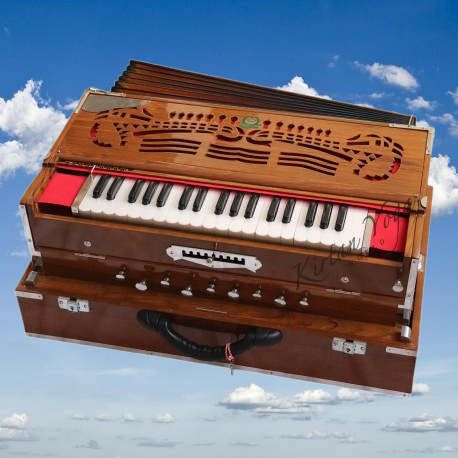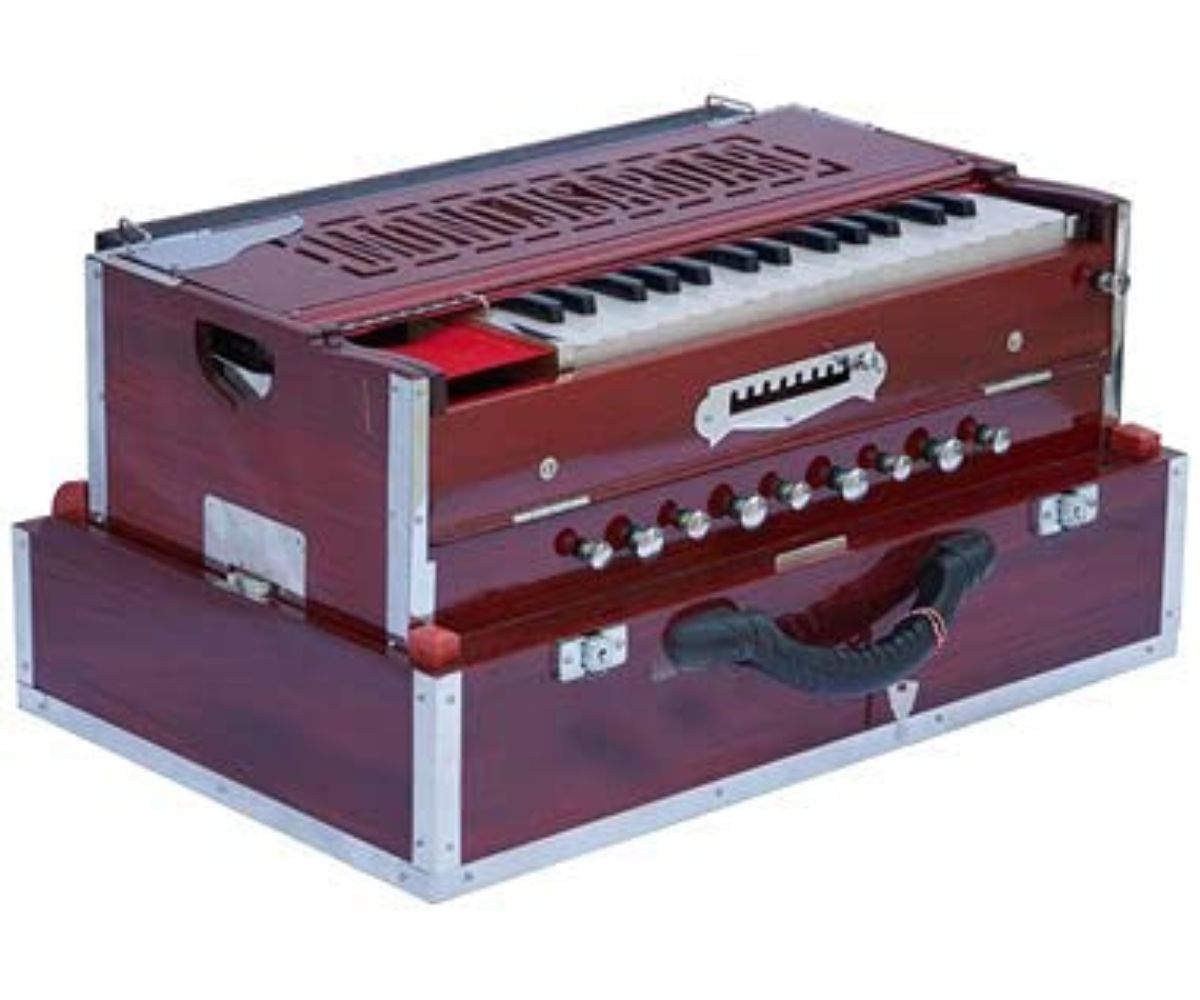harmonium
harmonium instrument sometimes known as a reed organ or keyboard is often used as a stand-in for the organ. It makes music by blowing air through reeds that have been adjusted to various pitches

.
A variety of shapes and sizes and may be played with either the feet or the hands.
The performer of a foot-pump harmonium uses his feet to alternately push two pedals. It’s hooked up to the bellows mechanism, which blows air into the reeds. This allows the gamer to play the keyboard with either hand. Alexandre Deben of Paris is credited with inventing this kind in 1842, however, comparable devices were developed in other locations at around the same time.
The bellows of a hand-operated are moved by the player’s pushing and pulling on a handle. This means he can only play the keys with one hand at a time while keeping the other hand on the bellows. Some musicians are able to pump enough air with one hand to continue playing the keys with the other when required.
Dwarkanath Ghosh created the hand-pump harmonium so that it could be played from the floor. South Asian nations such as India, Afghanistan, Nepal, Bangladesh, and Pakistan all make use of it. Hindustani classical music, Sufi music, bhajan and other devotional music, qawwali, theatre music, and sangat all employ it as an accompanying instrument.
As a form of entertainment, particularly traditional Kathak dance. Others started making tools that were essentially identical to the ones being used in India. Anton Haeckel of Vienna, Austria, invented the keyboard instrument known as the Fisharmonica, which has free reeds. The Seraphine, created by John Green, made music by forcing air through metal reeds. Such tools are currently only found in museums.

one-of-a-kind
Alexandre Deben, a Frenchman, patented the first harmonium on August 9, 1840, and it was first used publicly the same year. Bhishmadeva Vedi created the harmonium in addition to the swaramandal (a miniature veena-like instrument resembling the zither and autoharp). Manohar Chimote, one of his students, renamed the box harmonium the “Samvadini” when he successfully fit the swaramandal inside its confines. The strings may be played with one hand while the other is on the bellows, and the keys can be played with the other. It has a brand new ‘Gandhara’ tuning, developed by Chimote. Even though Hindustani classical music uses a whole range of 22 notes, this tuning for it added an Indian touch to the European scale.
Indian Patent No. 250197 for 22-Shruti-Harmonium was developed by Vidyadhar OK. For this purpose, he defined the terms “Naad” and “Shruti,” and he outlined the requirement that any stringed instrument be played in 22 microtones (Shruti). His research revealed significant dissimilarities between the 22 srutis and the equal temperament scale’s 12 notes. To achieve 22 Shruti inside 12 keys, his 22-Shruti-It has individual knobs below each key to adjust the reed. It’s a hand-operated harmonium with a few tweaks, so it can be played by anybody.
The Tanpura and all the notes of the 22-Shruti-Harmonium may be used to create any raga. In addition, the 22-Shruti-Harmonium may mimic the sound of an accordion if all its knobs are set to the middle position. The number of reed banks, the grade of wood used, and the musician’s talent all contribute to the unique character of each instrument’s sound.
There is a wide variety.
The Gold Standard
The most common kind of harmonium, utilized by musicians of all stripes and in homes around the globe, is the standard harmonium.
Second, a portable harp
The suitcase-shaped portable harmonium has a regular harmonium that may be stored within.
Scale Altering Mechanism
A scale changer is similar to a standard harmonium, with the exception that its keys are not permanently attached to the reed board. Instead, the keys are attached to a sliding plate that may be angled to enable one key to slip under another.

Quality Construction
The sound produced is dependent on the quality of the wood used. Hardwoods like teak and mahogany are used to craft some of the most highly regarded harmoniums because of the resonant sound they produce. This, however, renders them too cumbersome to be conveniently portable. Lighter woods like pine or cedar make its more portable, so keep that in mind while shopping. Perhaps a smaller, more portable harmonium would be preferable if you want to take it on trips.
Folding or regular harpsichord
The majority of harmoniums feature two side grips. These are the traditional designs, and they are the ones that are most often used. Some of it has a folding design that allows for convenient portability. One variety folds in on itself, with the bellows board covering the top when folded. The Bina brand is illustrative. These take some practice to fold and unfold, but once the user has mastered the process, they may be a convenient solution for taking on the road.
The second kind is folded inside out, and the whole unit is covered by a separate lid. The suitcase model describes this kind of structure. The removable cover doubles as a stand to elevate the instrument to a more comfortable playing height, and folding and unfolding them is a breeze. Since harmoniums often include heavier woods, they are typically more costly. Although they fold up quickly, they are nevertheless cumbersome when traveling.
Reed bank count and variety
The number of reed banks in a harmonium determines its tone. One may find harmoniums with anything from one to four banks of reeds. There are often four separate sets of reeds—male, female, bass, and tenor—in each of the four banks. The distinctive tone of each is achieved in part by the use of a variety of reeds in each of the instrument’s reed banks.
The more reed banks an instrument has, the more intricate its sound, but the more weight it also has to carry about. When playing it more reed banks often imply more range. The range of a it is with two or three reed banks is usually sufficient.

pitch shifter
Key changes, sometimes known as scale changes, may be found on certain harmoniums. To slide the keyboard to the left or right requires a sophisticated mechanism. Most of its players will never need to utilize this function.
Coupler
Connecting one key to its higher or lower matching key, the coupler is a feature found on certain harmoniums. When the coupler is activated, two instruments playing the same note in different octaves will sound like one. There are benefits and drawbacks to it. A bigger volume of sound may be produced with a lower number of reed banks, resulting in a typically fuller tone, which is a benefit when designing it. To keep the music going, the player will have to pump additional air into the instrument, which is inconvenient.
Air bellows
Bellows are used to pump air into the harmonium. The external bellows are just half of the story; the other half is hidden somewhere within. There may be 1, 3, 5, or 7 folds in the outer bellows.
It is up to the individual user to decide whether the bellows should expand laterally or vertically. It is important to ensure sure there is sufficient of air in the internal bellows since many (but not all) bellows that open at the top have stronger bellows springs. When it comes to providing enough air for the instrument, several side-pump blowers have a gentle pumping motion and can provide.
Range
Since various harmoniums have keyboards of varying sizes, their octave ranges also vary. Two and a half to three and a half octaves are possible per picture, sometimes even more. Smaller models with 2.5-octave keyboards nevertheless provide a large range of tones for everyday usage. Most players would never utilize all the keys on a 3.5-octave instrument, thus more is not always better. Common ranges for models include 3.5, 3.5, and 3.5.
Pauses and droning
Large knobs on the harmonium’s front generally release air into the instrument’s several air chambers. We refer to them as “stops.” These enable the player to play a single set of reeds or all of them, with individual control over the quantity of air entering each set.
Drones may be found in the form of front-mounted knobs on certain versions. When the dial is turned all the way to the open position, a constant drone sounds. Drones often use one of the key signatures of C#, D#, F#, G#, or A#. The notes may be altered to suit the individual’s needs. The All-Inclusive Price List
They’re also starting to make waves in mainstream western music.
Depending on its construction quality, number of keys, and other features, the cost of it may vary significantly.
What factors are influencing the cost
There are a number of variables that may impact how much a harmonium can set you back.
Materials Quality: * A higher-quality harmonium may cost more owing to the instrument’s need for more costly components.
More keys mean more sounds, but it might also mean more money out of your pocket.
For example, many harmoniums include couplers, stops, and bellows that may be used as accessories. Its price may go up as a result of these upgrades, but the instrument will be more versatile and fun to play on.
Name of Brand:* The popularity and prestige of various harmonium brands vary widely. This might result in higher prices for harmoniums made by these companies.
importance of harmonium in particular
Its price may range from a few hundred dollars to ten thousand. The cost of it might vary based on the kind being purchased and the country of origin.
How to tell whether you’ve found a nice harmonium
Some things to consider when purchasing it
When shopping for a harmonium, it’s important to give some thought to which features are really necessary. Some features are appealing in theory but are never put to use in practice.
Take a look at your current financial situation: it may cost anything from a few hundred to tens of thousands of dollars. Setting a budget before going shopping will help you avoid going over your budget and falling into debt.
Think about what you want: Which harmonium do you value the most, and why? You need how many keys? Like couplers and stops on it? You may begin your search for the ideal it after you have a firm grasp of your needs.
It’s a good idea to demo a few harmoniums before settling on one to purchase. Playing two or three harmoniums at once is far better than playing just one. You may use this information to choose a fantastic.
The number of reed banks, the grade of wood used, and the musician’s talent all contribute to the unique character of each instrument’s sound.
Where can one get it if anywhere at all?
It may be purchased from several retailers, including:
Record Stores: It may be found in almost any music shop nowadays. This is a great spot to try out a few different harmoniums before making a final decision.
* **Online Shops** The internet is rife with places to buy it, and Amazon stores are the best option for online purchasing it. This might be the best option if you’re looking for a certain harmonium but don’t have easy access to a music store in your area.
**conclusion**
There is a harmonium that meets your financial and aesthetic requirements. When shopping it’s important to think about the instrument’s brand, features, number of keys, and construction quality. It’s also a good idea to demo a few harmoniums before settling on a purchase.
Additional Tips for Purchasing
If you’re looking to buy it online, I’d recommend reading through several reviews first. You may use this information to **avoid buying a subpar instrument that lacks the features you need.
If you’re shopping for it in a music store, it’s a good idea to consult with an employee there about which model would be the greatest fit for your requirements and budget.
Take careful care of your harmonium after purchasing it. Illness is likely to persist with this aid. The paraphraser in Bot will take your phrases and modify them, allowing you to rewrite and restate text rapidly and easily. To know more about music read our most readable article https://shaktiknowledge.com/history-of-indian-music/










